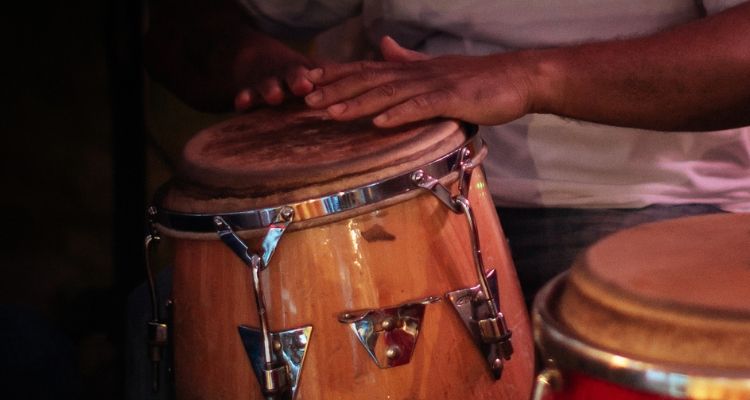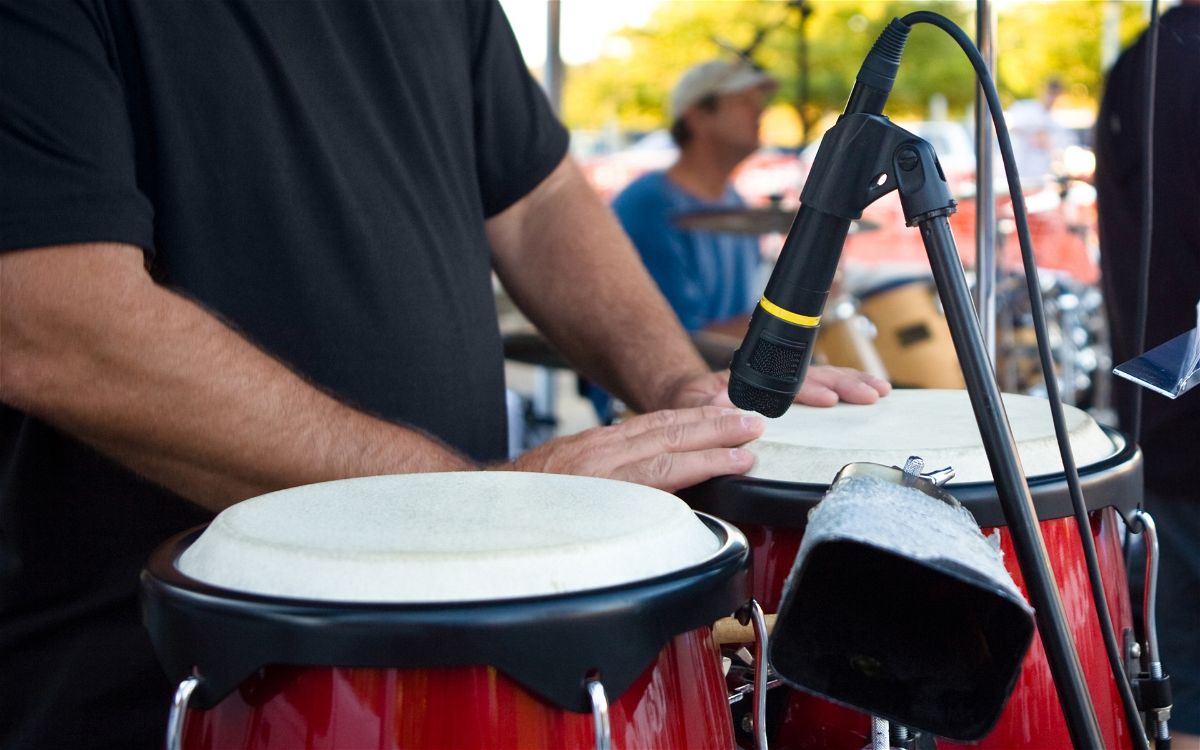Congas are really fun to play. They offer deeper tones than bongos, and you can fit more than two of them in a setup if you want to.
I really enjoy how they feel on my hands. Striking a conga is really satisfying, especially when you string together interesting patterns to create vibrant rhythms.
In this guide, I’m going to show you eight different rhythms to get you started on the congas. They’re relatively simple, so they should be easy to learn.
Contents
How to Strike Congas

There are a few different ways to strike congas to get different tones. When playing a set of congas, you have to use all these striking methods to create diverse sounds across all the rhythms you play. So, learn how to do all of them and use them when trying out the rhythms that I’m going to show you.
Open Stroke
An open stroke is the most natural and standard way of hitting a conga. You’re going to cup your fingers slightly and hit the drumhead of the conga with the base of your fingers. You’ll then feel natural rebound, causing you to lift your hands after each stroke.
You can do this stroke near the edge or in the center of a conga. The sound you get will have a medium volume with a good amount of resonance.
Muted Stroke
A muted stroke sounds a lot more distinct than an open stroke. The goal is to completely cut away the resonance of the conga, leaving you with a short tone.
To do that, you need to leave your hand on the drumhead after striking it. This takes away all the force, stopping the shell from resonating.
Just be careful not to do this all the time, as that stops the congas from sounding musical. It works best when you mix the stroke in with all the others when playing patterns and rhythms.
Slap Stroke
For a slap stroke, you’re going to stiffen your fingers and then strike the edge of the conga. This is very similar to playing a rimshot on a snare drum. You get a powerful sound. It sounds quite thin, though, so it’s another stroke that you shouldn’t use very often.
I’d just recommend using it when you want to play an accent and make it count. Some congas produce much sharper sounds than others when you play slap strokes, so that’s something else to keep in mind.
Touch Stroke
A touch stroke is when you softly tap the drumhead with your fingers. While a slap stroke is like a rimshot, a touch stroke is like a ghost note.
These strokes will sound incredibly subtle, but they’re so effective in creating dynamic and musical rhythms.
Conga Patterns for Beginners
While you can have several congas in a setup, all the patterns I’m about to mention just involve using two. That’s the most common setup, and it makes it a bit easier when you just focus on playing a higher-pitched and lower-pitched option.
Pattern 1

This first pattern is a simple repeating rhythm. You’re going to play a consistent string of eighth notes, and you’re going to switch between the two congas in your setup. You’ll play four notes on the lower-pitched conga drum and then four notes on the higher-pitched one.
I’d recommend playing this in two ways. Firstly, you can keep one hand on each conga and play four notes per hand. You can then try alternating your hands for each note and move them side to side. Both of these methods will train your hands to feel more fluid.
Pattern 2

This next pattern looks a bit complicated due to how the notes appear, but it’s another fairly simple rhythm to play on the congas.
You’ll start by playing two notes on the deeper conga. The first note will fall on beat 1, while the second will fall on the “a” count of beat 1.
You’ll then play the higher conga on the “and” count of beat 2. Repeat that pattern again to finish the bar. This rhythm has a bouncy sound, which I love.
Pattern 3

Now, we’re going to add 16th notes into the mix. You’ll play a quick group of three on the lower conga and then you’ll play two eighth notes on the higher one.
For this particular pattern, you’ll need to alternate your hands to play those 16th notes comfortably. If you try to play them with just one hand, you’ll end up feeling quite stiff.
I’d also recommend playing the notes on the lower conga as open strokes and then playing the higher conga notes as slap strokes. That will make it sound quite cool!
Pattern 4

Here’s an incredibly common conga rhythm. I can’t tell you how many times I’ve heard this being played, as it tends to fit very musically within a lot of songs.
You’re going to keep each hand on a conga while playing it, as it’s a basic group of eighth notes.
You’ll start by playing a quarter note on the lower conga. You’ll then play two eighth notes on the higher one, another two eighth notes on the lower one, and then you’ll end off with a strong quarter note on the higher conga again.
Pattern 5

This pattern is quite similar to the second pattern that we looked at, considering it has a bouncy feel with a few gaps in between notes.
You’re going to focus on playing the lower conga quite strongly, forming a solid three-note phrase in the bar.
You’ll then add the higher conga on the “and” of beat 1 and on the “e” of beat 2. You’ll then repeat that for beats 3 and 4.
Pattern 6

This pattern is a fantastic one to work on the fluidity of your hand movements when playing the congas.
You’re going to play straight sixteenth notes. The first three in a group will be on the lower conga, while the last one will be on the higher. Alternating your hands and moving quickly to the high conga is what makes this a bit tricky.
Once you get used to it, you could also swap the notes around so that you’re only playing a single low conga note in each group. Doing that will help you develop your hand dexterity when going both ways.
Pattern 7

Here’s another incredibly popular conga pattern. This is one that you’ll hear being played on countless songs, as it fits so well with different styles of music.
You’re going to start with a rest on beat 1, and then you’ll play two quick sixteenth notes starting on the “and” of 1. You’ll then do the same thing on beat two, but you’ll play it on the second conga.
You get a sort of heartbeat rhythm happening here, which sounds really great with the lower-pitched sounds of congas.
Pattern 8

Our last pattern is another fun one to play. It has quite a bouncy sound, especially when you play it at a high tempo.
You’re going to start by playing a group of four sixteenth notes on the higher-pitched conga. You’re then going to play two eighth notes on the lower-pitched one.
You’ll repeat the same rhythm for the second half of the bar. However, you’re going to leave out the first sixteenth note on beat 3. That short space is what makes the rhythm sound so quirky.
Tips for Playing Congas
Use a Metronome
It’s always a good idea to use a metronome when learning new rhythms. The constant clicking sound will help keep you in time, and it will ensure that you’re playing the notes in the right places.
I’ve seen it happen often where beginners don’t use a metronome to practice, and they don’t realize that they’re playing patterns slightly off.
Play to Music
The cool thing about congas is that they fit in any style of music. If you want to have more fun while practicing all the patterns I mentioned, you can play them to all of your favorite songs.
Since congas don’t have certain pitches, the sound will gel well with anything. So, playing a basic clave pattern will sound great with a modern pop song.
I often like to do this when taking a break from practicing with a metronome. Since professionally made music tends to stick to a solid BPM throughout a song, it works just as well.
You can also find some cool play along tracks on YouTube that are made for congas.
Add Bongos to the Mix
It’s common to have a full percussion setup where you mix bongos and congas. The sounds of these drums blend so well together, so learning to play both is a great idea.
The techniques used to play bongos are slightly different, but the patterns are mostly the same. If you can get your hands on a pair of bongos, try playing them with your congas!
Conclusion
All the rhythms I mentioned above are quite simple, but they’re important in developing a good foundation for playing patterns. Once you get them down, you can start exploring traditional Latin conga patterns like claves and calypso rhythms.
Those are much trickier, but they’re what most professional percussionists play when jamming on congas!









